The map format OpenDrive, provides (among others) the geometry of a road. Each segment of the road can have a different geometry (e.g. line, arc, spiral, polynomial). The provided information for a road geometry "spiral", is the following:
- s - relative position of the road segment in respect to the beginning
of the road (not used in here)
- x - the "x" position of the starting point of the road segment
- y - the "y" position of the starting point of the road segment
- hdg - the heading of the starting point of the road segment
- length - the length of the road segment
- curvStart - the curvature at the start of the road segment
- curvEnd - the curvature at the end of the road segment
My goal is to interpolate points along the spiral, given a "resolution" parameter (e.g. resolution = 1, interpolates a point along the spiral each meter). The spiral geometry is such that it introduces a constant change in curvature (1/radius), so that it creates a smooth and stable transition from a line to an arc, so that lateral acceleration forces on a vehicle are smaller then a transition from a line to an arc directly (line curvature = 0, arc curvature = constant).
The spiral always has one of it's ending points with a curvature of 0 (where it connects to the line segment of the road) and the other as a constant (e.g. 0.05 where it connects to an arc). Depending on the connection sequence, curvStart can be equal to 0 or constant and curvEnd can be also equal to 0 or constant. They cannot be both equal to 0 or constant at the same time.
The code below is a function that takes as arguments the previously discussed parameters (given by the format) and the resolution.
Currently, I am experiencing troubles with the following:
- Interpolate equidistant points of 1 meter apart (check plot 1)
- Obtain the correct heading of the points (check plot 2)
- Find a solution for the last 2 cases
From my research on how to fulfill the task, I came upon few helpful resources, but none of them helped me obtain the final solution:
- OpenDrive Specification
- Open source road generation and editing software - page 40(31)
- Euler Spiral Wiki
- Cephes library, from which the scipy.special.fresnel function is derived
- Klothoide - the German version of the "Clothoid" Wiki page has more formulas
- Parameterized function for clothoid
- SciPy: What are the arguments in
scipy.special.fresnel(x\[, out1, out2\])? - where it is pointed out that "scipy implementation of the function scales the argument by pi/2"
import numpy as np
from math import cos, sin, pi, radians
from scipy.special import fresnel
import matplotlib.pyplot as plt
%matplotlib inline
def spiralInterpolation(resolution, s, x, y, hdg, length, curvStart, curvEnd):
points = np.zeros((int(length/resolution), 1))
points = [i*resolution for i in range(len(points))]
xx = np.zeros_like(points)
yy = np.zeros_like(points)
hh = np.zeros_like(points)
if curvStart == 0 and curvEnd > 0:
print("Case 1: curvStart == 0 and curvEnd > 0")
radius = np.abs(1/curvEnd)
A_sq = radius*length
ss, cc = fresnel(np.square(points)/(2*A_sq*np.sqrt(np.pi/2)))
xx = points*cc
yy = points*ss
hh = np.square(points)*2*radius*length
xx, yy, hh = rotate(xx, yy, hh, hdg)
xx, yy = translate(xx, yy, x, y)
xx = np.insert(xx, 0, x, axis=0)
yy = np.insert(yy, 0, y, axis=0)
hh = np.insert(hh, 0, hdg, axis=0)
elif curvStart == 0 and curvEnd < 0:
print("Case 2: curvStart == 0 and curvEnd < 0")
radius = np.abs(1/curvEnd)
A_sq = radius*length
ss, cc = fresnel(np.square(points)/(2*A_sq*np.sqrt(np.pi/2)))
xx = points*cc
yy = points*ss*-1
hh = np.square(points)*2*radius*length
xx, yy, hh = rotate(xx, yy, hh, hdg)
xx, yy = translate(xx, yy, x, y)
xx = np.insert(xx, 0, x, axis=0)
yy = np.insert(yy, 0, y, axis=0)
hh = np.insert(hh, 0, hdg, axis=0)
elif curvEnd == 0 and curvStart > 0:
print("Case 3: curvEnd == 0 and curvStart > 0")
elif curvEnd == 0 and curvStart < 0:
print("Case 4: curvEnd == 0 and curvStart < 0")
else:
print("The curvature parameters differ from the 4 predefined cases. "
"Change curvStart and/or curvEnd")
n_stations = int(length/resolution) + 1
stations = np.zeros((n_stations, 3))
for i in range(len(xx)):
stations[i][0] = xx[i]
stations[i][1] = yy[i]
stations[i][2] = hh[i]
return stations
def rotate(x, y, h, angle):
# This function rotates the x and y vectors around zero
xx = np.zeros_like(x)
yy = np.zeros_like(y)
hh = np.zeros_like(h)
for i in range(len(x)):
xx[i] = x[i]*cos(angle) - y[i]*sin(angle)
yy[i] = x[i]*sin(angle) + y[i]*cos(angle)
hh[i] = h[i] + angle
return xx, yy, hh
def translate(x, y, x_delta, y_delta):
# This function translates the x and y vectors with the delta values
xx = np.zeros_like(x)
yy = np.zeros_like(y)
for i in range(len(x)):
xx[i] = x[i] + x_delta
yy[i] = y[i] + y_delta
return xx, yy
stations = spiralInterpolation(1, 77, 50, 100, radians(56), 40, 0, 1/20)
x = []
y = []
h = []
for station in stations:
x.append(station[0])
y.append(station[1])
h.append(station[2])
plt.figure(figsize=(20,13))
plt.plot(x, y, '.')
plt.grid(True)
plt.axis('equal')
plt.show()
def get_heading_components(x, y, h, length=1):
xa = np.zeros_like(x)
ya = np.zeros_like(y)
for i in range(len(x)):
xa[i] = length*cos(h[i])
ya[i] = length*sin(h[i])
return xa, ya
xa, ya = get_heading_components(x, y, h)
plt.figure(figsize=(20,13))
plt.quiver(x, y, xa, ya, width=0.005)
plt.grid(True)
plt.axis('equal')
plt.show()
